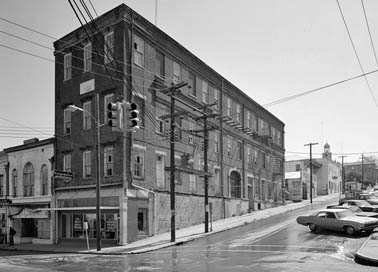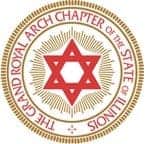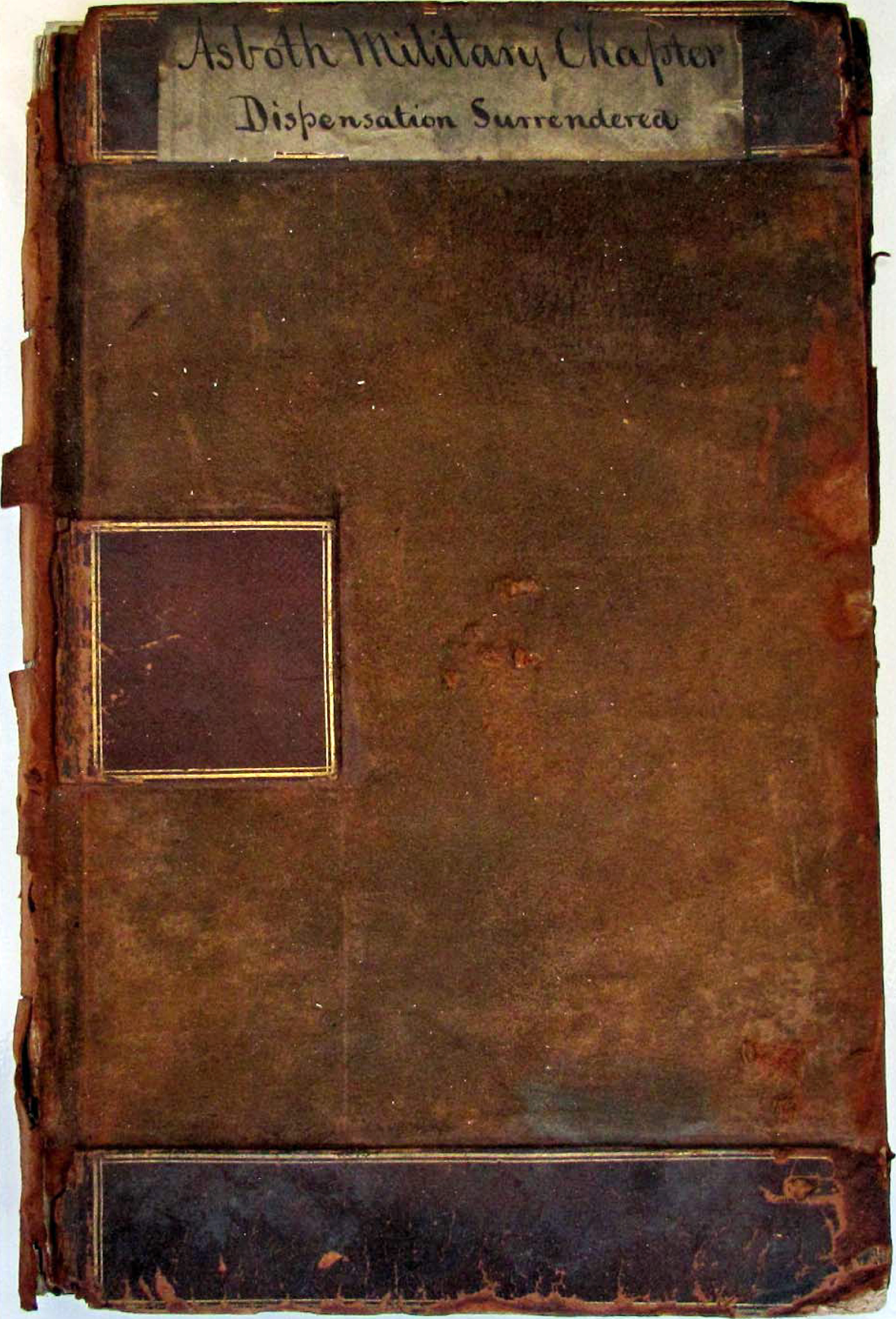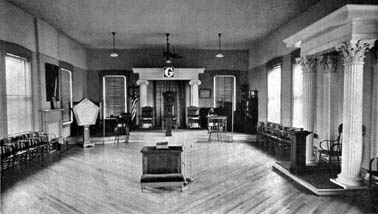Rare Civil War Military Chapter records found in Grand Royal Arch Chapter of Illinois archives
by Paul Scheeler
PHP, La Fayette Chapter No. 2, Chicago
Past Master, Illinois Lodge of Research
During this sesquicentennial of the American Civil War, it is particularly fitting that the 150-year-old minutes book for two military Royal Arch chapters, containing transcripts of meetings held during the 1861-1865 War Between the States has been discovered in the Grand Chapter of Illinois’ archives.
The ledger contains records for Asboth Military Chapter, U.D., instituted by authority of the Grand Royal Arch Chapter of the State of Illinois on 1 July 1863, and Hurlbut Military Chapter U.D., instituted 28 January 1864. Weighing 1.219 kilograms (2 pounds, 11 ounces), the 25.4 cm × 38.1 cm (10″ × 15″) volume is 2.5 cm (1″) thick, bound in brown cowhide leather with decorative patches, saddle-stitched, with marbled endpapers.
On the front cover is a large paper label which reads, “Asboth Military Chapter, Dispensation Surrendered”, perhaps affixed by then-Grand Secretary, Harman G. Reynolds.
Among the one hundred pages are detailed accounts, all neatly penned and most likely in quill ink, of business conducted and degrees conferred at meetings held in 1863 and 1864, first at Columbus, Kentucky, then at Vicksburg, Mississippi. If original, it would have been impossible for the ledger to have been used simultaneously by Asboth in Vicksburg, 589 kilometres (366 miles) south along the Mississippi River from Hurlbut in Columbus, during overlapping periods. Thus, the records of Hurlbut’s meetings were appended to Asboth’s entries at some point from another set.
“This extraordinary ledger is a treasure trove of previously unknown Masonic information. It documents a remarkable period in U.S. history when companions found themselves in the midst of the country’s greatest national crisis, yet nevertheless sought to devote time and effort to fraternal pursuits,” said Companion Paul Scheeler. “That Capitular Masonry was so highly prized by these men – even as the nation’s darkest hours unfolded around them – speaks to the enduring value of York Rite Freemasonry in the lives of citizens who supported and comprised the militia.”
Under Asboth’s first High Priest, S. O. Vaughan (later Secretary), Secretary Charles D. Haight dutifully recorded each meeting, degrees opened on, names of officers, members and candidates, petitions and ballots, funds received, etc. Pages are pre-numbered, with 1-37 absent, removed or never bound into the ledger, starting instead at page 38. The Asboth records extend to page 133; Hurlbut records stop at page 137/8, the last page in the book. A curious note on the cover page reads: “Captured at Vicksburg, Miss. July 4th 1863, at the Warehouse of Duff Green & Co.”
Also on the cover page is the following dedication:
Presented to the Asboth Military Chapter By Ira A. Batterton W. C. Hobbs Lodge No. 306 Eureka, Ill Vicksburg Miss
Feby 3, 1864.
(Note: this lodge was defunct by merger with Taylor No. 98 as of August 3, 1999). Thus, the donation of this ledger post-dates occurrence of minutes kept for meetings on preceding dates. This means that the ledger is, at least in part, a transcription from other documents, perhaps made by the Grand Secretary. This would account for the consistency of handwriting throughout the ledger and for both chapters.
A PDF file of the entire imaged ledger contents can be accessed here.
Asboth Military Chapter U.D.
On 1 July 1863, a dispensation was issued to Asboth Military Chapter UD, named for Brigadier General Alexander Asboth (nèe Asbóth Sándor
[Sándor is the Hungarian counterpart of Alexander, and Hungarian surnames traditionally preceded forenames]). It was officered by civilians attached to the military work at Columbus, Kentucky, where it met from 6 July 1863 until 20 January 1864, when it was removed to Vicksburg,
Mississippi, and it met there from 28 January to 24 February 1864, going defunct as of 25 February.
The Grand High Priest, Hiram W. Hubbard, a renowned ritualist who served as High Priest of no less than four chapters, went with the chapter to Vicksburg, where he observed upon arrival:
We found the Masonic Temple under control of the Military Authorities. The Lodge room was occupied by three Military Lodges, the Chapter room by the Military Commission, who cheerfully gave way. We found several Royal Arch Masons there from Illinois, and a number of the former officers and members of Vicksburg Chapter No. 3, who rendered every assistance in their power by furnishing robes, jewels and fixtures, and aiding in the work.
Hurlbut Military Chapter U.D.
When Asboth Military Chapter left Columbus, a few of the companions remained there. A dispensation was issued in January 1864 for Hurlbut Military Chapter UD, named for Major General Stephen Augustus Hurlbut (1815-1882), commander of the Army of the Gulf during the Civil War, earlier a lawyer in Belvidere and elected member of the Illinois House of Representatives.
Historical accounts by authors seem to reference original reports filed with the Grand Secretary which have not yet been located. These accounts concur with those in the ledger, that this chapter held only six convocations and conferred degrees upon four candidates, none being exalted in the Holy Royal Arch.
Ledger entries for Hurlbut are therefore minimal compared to Asboth, the last minutes being for a meeting held 11 February 11, 1864, as recorded by Secretary A. S. Jones. A notation at the bottom of the last page in the same handwriting indicates:
“The Balance of the Records of this Chapter have been lost. The above $90 was returned by the Grand High Priest and paid to PM Vaughan for services. Those receiving degrees were all furnished with certificates from the Chapter and their names were reported to the Grand Chapter of Illinois. S O Vaughan, H P of Asboth Military Chapter UD”
Historic Columbus, Kentucky
While no images of the Columbus Masonic Temple have yet been found, the small town’s claim to historical fame occurred in September 1861,
when Confederate forces seized the town and blocked the Mississippi River by stretching an anchor chain from the Columbus bank to that of
Belmont (Mississippi County), Missouri. Columbus-Belmont State Park memorializes the battle.
The Vicksburg Masonic Temple
Formerly located at the corner of Grove and Washington Streets, in Vicksburg, Mississippi, this temple was constructed in 1848 and razed in 1973 as part of an urban renewal plan. As of early 2013, an online aerial view of the vacant land, showed it remained undeveloped.
The photo above of the well-appointed interior of the lodge/chapter hall appears in 1850-1950 Centennial History of the Grand Royal Arch Chapter of the State of Illinois, by Everett R. Turnbull, MEPGHP. Exterior photographs including the one below were produced in 1972 by the Library of Congress’ Historic American Buildings Survey, the year before the temple’s demolition. Less than two blocks west of the building are the Illinois Central Railroad running along the Mississippi River.

The simple yet substantial building, an example of late Georgian architecture, had cast-iron lintels, brick pilasters and cornices. The brick entablature consisted of a wide capitular architrave and frieze, and a cornice with dentils ran across the east and south sides. The large stone inset on the west side, between the second and third floors, bore a Square and Compasses, within a capitular archway, flanked by a level and plumb. The south entrance at 717 Grove Street was converted into a window, and featured a capitular architrave, the keystone of which was inscribed with the square and compasses.



